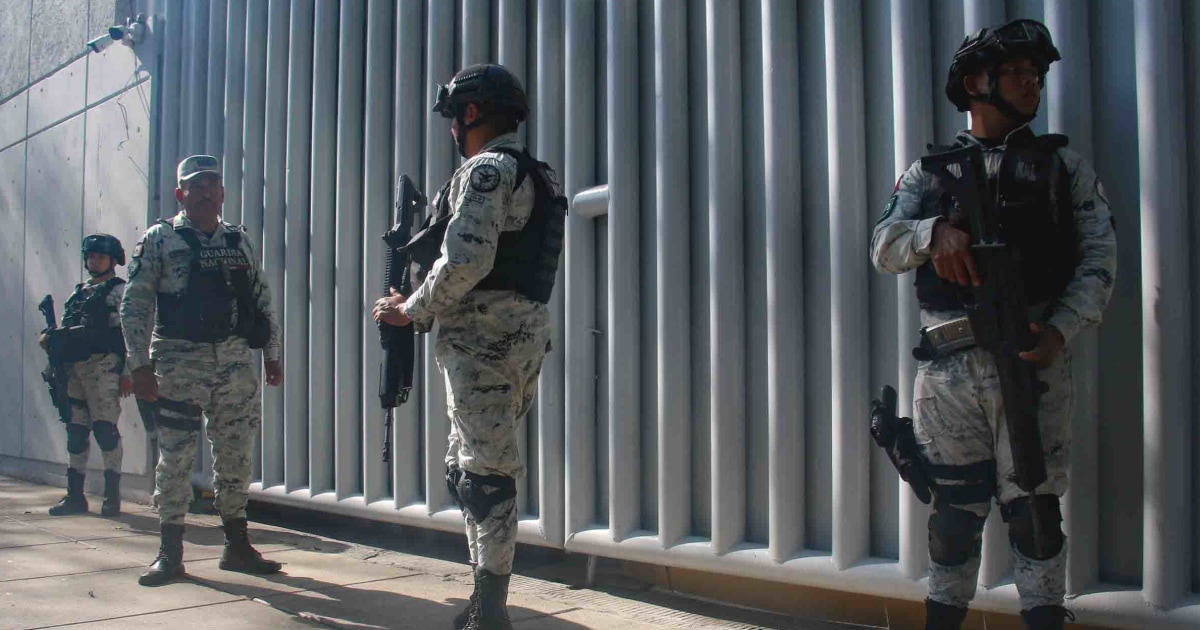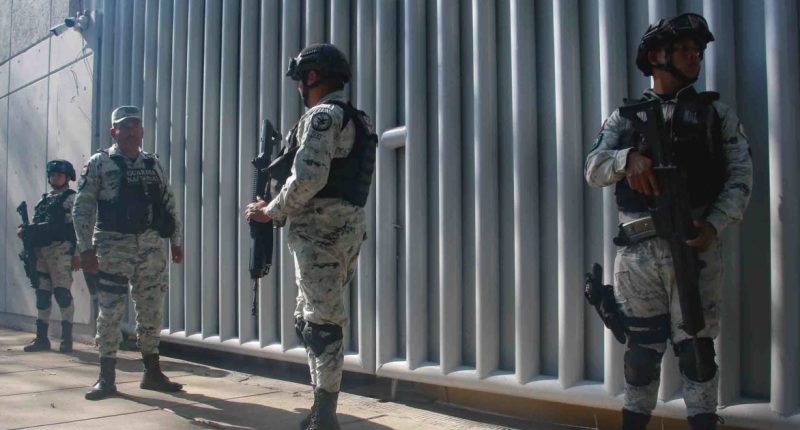
The proposals of Republican presidential candidate such as Ron DeSantis, Vivek Ramaswamy and Nikki Haley supporting the deployment of U.S. military personnel to Mexico and the use of drones with bombs to combat the drug cartels have been making headlines as of late.
In the Republican debate last week, Haley referred to the fentanyl problem in the U.S. and said that Mexico was not a good partner if the U.S. lost 75,000 Americans last year and Mexico allowed cartels to get their way. She said she would “send in our special operations and we will take out the cartels.”
The power of Mexican cartels drew wide attention after a recent study published in the journal Science found organized crime groups collectively “employ” an estimated 175,000 people in Mexico.
That would make cartels the fifth-largest employer in the country, according to researchers Rafael Prieto-Curiel, Gian Maria Campedelli and Alejandro Hope.
According to the findings, the labor power of Mexico’s cartels is only surpassed by a few large companies in Mexico, including the beverage multinational Femsa, Walmart, Manpower and the telecommunications giant América Móvil.
Over 200,000 Americans have overdosed and died from synthetic opioids like fentanyl since 2020, according to the Centers for Disease Control and Prevention.
However, “drug addiction in the U.S is not solved by bombing Mexico,” Prieto-Curiel said in an interview with Noticias Telemundo. “One could also think that the problem of drug trafficking lies with the consumers,” positing that it’s not as if the U.S. carries out military operations in U.S. cities to control the fentanyl problem.
Mexico as a topic in U.S. political speeches and debates is not new; U.S. political candidates have often blamed their neighbor for rising migration numbers, drug-related fatalities and drug trafficking.
Mexican President Andrés Manuel López Obrador has pushed back on the U.S. Republican proposals to deploy security forces to Mexico, calling them “nonsense” and telling the almost 40 million Mexicans who live in the U.S. they shouldn’t support candidates who formulate these plans.
“They speak without support because they think that this way they will gain sympathy,” López Obrador said in recent statement. “They compete among themselves to see who says the most extravagant nonsense about migration, fentanyl and about Mexico, but we should not take them seriously.”
Reducing numbers
When it comes to cartels, the recent research found that although they lose dozens of members every day to slayings or the actions of law enforcement, the violence perpetrated by cartel activity hasn’t decreased in recent years because the groups are always gaining new members.
According to the new report, combating such recruitment is the great hope to putting an end to the violence in a country that, in 2022 alone, recorded 32,223 homicides, or 88 murders a day.
The arrest of cartel leaders, government crackdowns and even peace negotiations with cartels wouldn’t decrease cartel violence as much as reducing the number of people who work for the criminal organizations, according to the study’s mathematical models.
“We saw a great reduction in violence if recruitment is reduced, while doubling repression is not even close to that,” Prieto-Curiel said in the interview.
According to their research, there has to be more focus on how the cartels recruit, whether it’s through the use of threats or the allure of working for these organizations and making money amid scarce jobs. There also has to be more emphasis on the risks of joining these organizations, since about a third of those working for cartels end up imprisoned or dead.
Within hours of the study’s publication, the findings of Prieto-Curiel, Campedelli and Hope (who died at the end of April and was one of Mexico’s most noted security analysts) garnered attention from the media and political leaders.
The Mexican government denied the findings, accusing the researchers of “exaggerating figures.”
“It is a mathematical simulation, whose results obtained are false assumptions,” Ana Elizabeth García Vilchis, a spokesperson for López Obrador, said at a recent news conference. “It is not true that organized crime is the fifth-largest employer in the country, as has been reported.”
Regarding the government’s response, Prieto-Curiel said that “as expected, the results do not favor the government’s policies and then they attack the messenger and do not dedicate themselves to confronting the article’s message, which tells us that the cartel and organized crime in Mexico is today a gigantic institution and is gaining ground, as we are seeing in Chiapas or Nuevo León.”
‘A dark universe’
Prieto-Curiel, who’s a postdoctoral researcher at the Complexity Science Hub in Vienna, explained how he used mathematical modeling to study the cartels, after experiencing the ravages of Mexico’s violence up close.
“I worked as a police officer for five years, and I was dedicated to using mathematical equations and models to predict the occurrence of crimes in the city. Since then I have been interested in security issues,” he said.
“We try to get as close as possible to reality. It is a dark universe, where there is no data because there is no census of the cartel, there is no affiliation, we have no dimensions,” Prieto-Curiel said.
Guadalupe Correa-Cabrera, a specialist in drug trafficking and migration at George Mason University, takes issue with the way Prieto-Curiel and his colleagues arrived at their numbers.
“For me, the fundamental problem is that they are calculating an approximate figure and consider the cartels as companies that manage monopolies, and that is not the case,” she said. “They are networks made up of different organizations, sometimes larger cells or groups, and not all of them work the same.”
Still, the U.S. recently testified about the large numbers of people employed in cartels: Drug Enforcement Administration Director Anne Milgram told Congress in July that Mexico’s two most powerful criminal organizations — the Sinaloa cartel and the Jalisco Nueva Generación cartel — had nearly 45,000 members between partners, facilitators and intermediaries in more than 100 countries.
‘At 11 I committed my first murder’
The researchers estimate that Mexican cartels must recruit 350 to 370 people a week to counteract the impact of arrests and killings in their ranks, and specify that the majority of people who join the gangs are men 14 to 18 years old.
Mercedes Castañeda knows many of the people who have been recruited by the Mexican mafias and have managed to leave the criminal networks to seek a better life. The co-founder of Reinserta, a Mexican nonprofit that develops protection programs focused on children and youth, Castañeda said the research findings corroborate what people escaping gangs often say.
Since its creation in 2013, Reinserta has served more than 1,300 adolescents who have been in criminal organizations and currently supports 250 young people in its programs.
One of them is Iván.
“At 11 years old I committed my first murder…together with two other hitmen we tortured the guy. My life changed after that, it’s no longer the same with my family, with my mother, with my father; you feel a weight,” said Iván, a young man AGE? who has participated in Reinserta programs and whose story is detailed in a recent report from the organization.
“I think that this investigation is very laudable because it puts numbers to the problem and analyzes it from an economic perspective, which is something very new,” Castañeda said about Prieto-Curiel and his colleagues’ research. “Mexico has a serious problem of children and adolescents who are involved in organized crime, and we must talk about that.”
In 2019, the Network for Children’s Rights in Mexico estimated that some 30,000 children and adolescents have been incorporated into the ranks of organized crime, though experts state there are no exact figures.
“We have seen a serious increase among the little ones, boys and girls, that drug traffickers put them in their gangs. … We are leaving our young people completely helpless,” Castañeda said.
“The state has to offer opportunities to children before they are recruited by the cartel and join one of the most violent careers that can exist,” Prieto-Curiel said. “In the 10 years after recruitment, the person who enters the cartel has a 17% probability of death due to murder and 20% of ending in jail. That is, 1 in 3 every three recruits will end up in jail or dead within a period of 10 years.”
Campedelli, a co-author and researcher at the MobS Lab of the Bruno Kessler Foundation in Italy, said that researchers were aware of the risks involved in investigating drug trafficking, especially at this time of social polarization.
“We knew that some leaders from one side or the other of the political spectrum can take our results to defend their opinions, but we only want to show the problem of cartel recruitment,” Campedelli said. “We do not have any political agenda.”
A version of this article was first published in Noticias Telemundo.
Source: | This article originally belongs to Nbcnews.com










